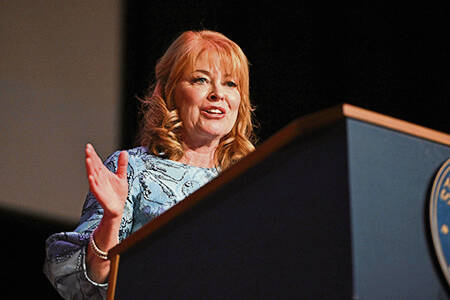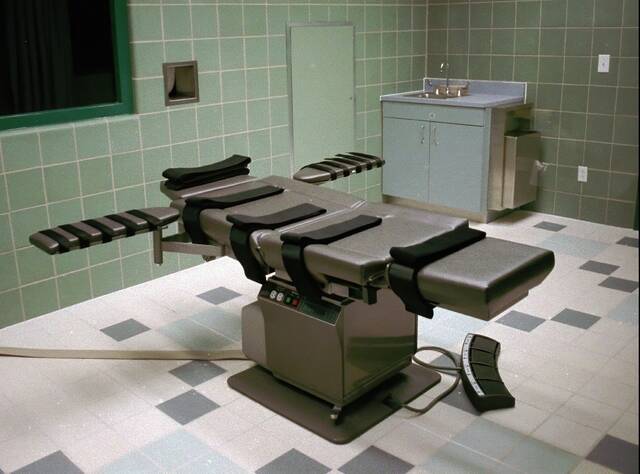The state trooper who interviewed Jordan Brown the morning his father’s pregnant fiancee was killed said it never even crossed her mind that the 11-year-old boy could have done it.
But as that day — Feb. 20, 2009 — wore on, the most likely suspects were eliminated, now-retired Cpl. Janice Wilson testified, and more and more evidence began to point at the fifth-grade student.
“We had several reasons to believe Jordan could be a possible suspect,” she said.
Wilson and her defense attorney, Nicole Boland, ticked them off for the jury.
Kenzie Houk, 26, had been killed with a shotgun. Brown had a shotgun.
Brown’s shotgun smelled like it had been recently fired.
Brown told Wilson that morning that he had seen a black pickup truck on the property, but when pressed later in the day gave a different description of what he’d seen.
And — what the state police said they found to be vitally important — the tree-cutting crew who found Houk’s 4-year-old daughter crying at the front door that morning said that there was a fresh coating of snow on the long driveway. While there were two sets of children’s footprints leading away from the house, the workers said, there were no tire tracks.
That meant, Wilson said, no one else could have come and gone from the property.
The troopers then began to narrow in on Brown, charging him in the early morning hours of Feb. 21, 2009. The arrest launched a years-long odyssey through the criminal justice system for Brown. He was adjudicated delinquent in 2012 of first-degree murder and ordered to remain incarcerated.
While he was released at age 18, Brown, who has always maintained his innocence, continued to pursue his appeals.
In July 2018, the state Supreme Court reversed his juvenile conviction, finding that there was not sufficient evidence against Brown to sustain a verdict of guilt beyond a reasonable doubt.
Two years later, Brown, who wants to clear his name, sued Wilson and her fellow retired troopers, Jeffrey Martin, Troy Steinheiser and Robert McGraw, now deceased, alleging malicious prosecution and fabrication of evidence.
He claims that the troopers did not have adequate probable cause to charge him with a crime and that they failed to thoroughly investigate Houk’s ex-boyfriend who had been violent with her in the past.
He is seeking financial damages.
Trial in the case began on Dec. 4 before U.S. District Judge W. Scott Hardy and will be divided into two phases. In the first, the eight-person jury must decide whether the troopers are liable for Brown’s claims. If the panel finds that they are, the case will move into a damages phase.
It is only then that Brown and his attorneys can present evidence of the harms he experienced after his arrest and during seven years of incarceration.
Boland told the court on Tuesday that the defense has two more witnesses. One of them is expected to be Houk’s then-7-year-old daughter, Jenessa. Closing arguments in the first phase are likely Wednesday afternoon.
Wilson spent nearly three hours on the witness stand on Tuesday. She told the jury that she retired from the state police in 2009 after a 25-year career with the agency.
After her planned retirement, Wilson said, she was then hired to be a forensic interviewer with the Lawrence County Child Advocacy Center. She continues to work in that capacity.
That was an interesting fact elicited in Wilson’s testimony since the plaintiffs have asked witnesses repeatedly if, on the day of Houk’s death, the state police had access to a child forensic interviewer.
They said they did not. Wilson told the jury that she didn’t receive specific training for her current position until after she left the state police.
Still, she said, she had previously worked as a juvenile probation officer and had extensive experience interviewing children.
That’s why, Wilson said, her supervisors that day dispatched her to interview the children who had been in the home that morning before Houk was killed.
Wilson went to Mohawk Elementary School and spoke separately with Jenessa Houk first and then Brown. She did not tell them that Kenzie Houk was dead and instead just asked them to describe what happened before they left for school.
Neither child provided much information at that time, Wilson said.
But, she noted, Jenessa Houk’s demeanor was strange. The girl was already crying when she walked into the conference room to talk. And while she calmed down as they interview continued, when it ended, Wilson said, Jenessa Houk appeared to be troubled.
“She looked upset and like she was going to cry again, and I asked her if there was anything else she wanted to say,” Wilson said. “She said no.”
Later, Jenessa Houk, who was interviewed four times by state police that day, changed her story, telling troopers that she saw Brown carry two long guns downstairs and upstairs that morning. She also said she heard “a big boom,” that sounded like a gun.
Wilson said the troopers never introduced the idea of Brown having guns or the sound of a gun to the girl, and that Jenessa Houk brought it up on her own.
After the girl gave the new statement, Wilson said she asked her why she hadn’t told her about the guns and sound that morning.
“She just shrugged her shoulders and said she didn’t know.”
Wilson told the jury she believed it was dissociation.
“In her mind, somewhere, she knew if she thought about or considered the boom, she would know something happened to her mom,” she said. “If she could block that from her mind, then her mother wouldn’t be dead.”
When Wilson and McGraw interviewed Brown for the second time that day, she said, the boy lied to them, saying that he hadn’t fired the 20-gauge shotgun for a month, even though he’d just used it in a turkey shoot a few days prior.
She also described the moment when Brown’s father, Chris, told him that Houk and the baby she was carrying had died.
“Jordan cried very briefly, tears streaming down his face,” she said. “He seemed to recover quickly from it. He didn’t ask any questions about what happened. He didn’t ask anything about the baby that was soon to be born.”
Earlier Tuesday, state police Maj. William A. Maitland also testified.
Now an area commander, at the time Kenzie Houk was killed, he was a corporal in New Castle. Maitland was a supervisor in the criminal investigation unit and helped direct the investigation.
First responders did not initially know Houk had been shot, he told the jury. It wasn’t until the coroner arrived that they realized they were dealing with a homicide investigation and not a natural death.
“I told everybody we needed to clear the house and secure it and create a crime scene log,” Maitland said.
They also activated the major case team, which brought in additional state police resources from the surrounding area.
After investigators eliminated Chris Brown as a suspect, Maitland said, they turned their attention to Kenzie Houk’s ex-boyfriend. Several of her friends and relatives suggested that the ex, who had been violent with her in the past and was the subject of a restraining order, could have been responsible.
Earlier in the trial, another state trooper testified that he believed Maitland had gone to high school with Houk’s ex-boyfriend. However, during his testimony on Tuesday, Maitland said that is not true.
The only time he ever interacted with that man, Maitland continued, was in an an adult hockey league when he played against him a few times on an opposing team. They had never had a conversation, Maitland said, and they didn’t socialize.
He told the jury that the state police assigned one of their strongest interviewers to talk to the ex-boyfriend that day.
The man claimed that he had been with his father that day, and they called the dad to confirm the alibi. Maitland also noted that when troopers went to find the ex that afternoon, his dark-colored pickup truck still had snow all over it, indicating to them it hadn’t been moved that day.
The ex-boyfriend told investigators he had no recent contact with Houk and didn’t even know where she lived.
They did a gunshot residue test on him, and he offered to take a polygraph, though none was ever given. Maitland said they were unable to tie the ex to the crime scene, and the lack of tire tracks in the snow that day helped to eliminate him as a suspect.
“Somebody already at the residence committed this crime,” he said.
When Brown’s description of the pickup truck he had seen that morning changed, Maitland said, so, too, did the investigators’ thinking.
“There was no information that led us to believe it was anyone other than Jordan Brown.”








